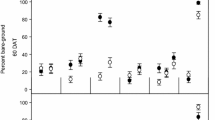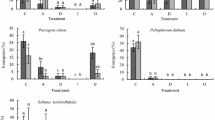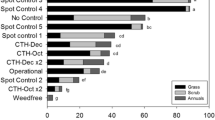Abstract
Salal (Gaultheria shallon) is a vigorous evergreen perennial shrub that is native to the west coast of North America, where it can reduce overstorey growth rates and negatively impact regeneration. Since its introduction into the UK almost a century ago it has become an increasing problem in many woodlands, where it completely shades out other understorey vegetation including young trees, preventing forest regeneration. Climate change is likely to favour its future spread in the UK, and in other regions which currently have a similar climate such as Ireland and northwest Europe. Non chemical management is only practical on a small scale, and to date efforts to control this invasive weed with herbicides have been largely ineffective. In our work we found that a single application of 2.69 kg active ingredient (a.i.) ha−1 picloram [as 11.2 l ha−1 Tordon 22 K (240 g l−1 picloram)] diluted in water plus the adjuvant Mixture B NF at 2% of final spray volume, applied between spring and midsummer, killed all treated plants within two growing seasons. Treatment with 3.84 kg a.i. ha−1 triclopyr [as 8 l ha−1 Timbrel (480 g l−1 triclopyr)] diluted in water plus Mixture B NF at 2% of final spray volume, sprayed initially when flower buds are swelling or flushed but vegetative buds are largely dormant (late April in southern Britain), with a repeat application made 4–8 weeks later, was also very effective. If triclopyr or picloram cannot be used, we also found that glyphosate can provide some control, but follow up treatment will be required. In addition, silvicultural practices such as the high density planting of heavily shade bearing species should be adopted to discourage subsequent reinfestation of cleared areas.









Similar content being viewed by others
References
AmegA Sciences (2009) Mixture B NF product label. www.amega-sciences.com. Accessed 16 Oct 2017
BCPC (2010) Small scale spraying. The British Crop Protection Council, Alton
Bennett JN, Lapthorne BM, Blevins LL, Prescott CE (2004) Response of Gaultheria shallon and Epilobium angustifolium to large additions of nitrogen and phosphorus fertilizer. Can J For Res 34(2):502–506
Blevins LL, Van Niejenhuis A (2003) Stand establishment decision aid for nutrient-deficient, salal-dominated sites. J Ecosyst Manag 3(1):3
Boateng JO, Comeau P (2002) Operational summary for salal complex. British Columbia Ministry of Forests, Victoria
BSBI (2017) Distribution map for Gaultheria shallon. Botanical Society of Britain and Ireland. www.bsbi.org. Accessed 16 Oct 2017
D’Anjou B (1990) Control of Salal. In: Vegetation management: an integrated approach—proceedings of the 4th annual vegetation management workshop, 1989, November 14–16. Vancouver, BC. FRDA report 109. Ministry of Forests, Research Branch, Victoria, pp 25–26
DAISIE (2017) Gaultheria shallon species factsheet. Delivering Alien Invasive Species Inventories for Europe. www.europe-aliens.org. Accessed 16 Oct 2017
DEFRA (2006) Pesticides. Code of Practice for using plant protection products. Department for Environment, Food and Rural Affairs, London
Dow AgroSciences (2007) Timbrel herbicide product label. www.uk.dowagro.com. Accessed 16 Oct 2017
Dow AgroSciences (2012a) Forefront T herbicide product label. www.uk.dowagro.com. Accessed 16 Oct 2017
Dow AgroSciences (2012b) Tordon 22K herbicide product label. www.uk.dowagro.com. Accessed 16 Oct 2017
Edwards C (2006) Managing and controlling invasive rhododendron. Forestry commission practice guide 17. Forestry Commission, Edinburgh
Forestry Commission (2011) Forests and water: UK forestry standard guidelines. Forestry Commission, Edinburgh
Fraser L, Turkington R, Chanway CP (1993) The biology of Canadian weeds. 102. Gaultheria shallon Pursh. Can J Plant Sci 73:1233–1247
Hale S (2004) Managing light to enable natural regeneration in British conifer forests. Forestry Commission information note 63. Forestry Commission, Edinburgh
Hothorn T, Bretz F, Westfall P, Heiberger RM (2008) multcomp: simultaneous inference in general parametric models. R package version 1.0-0. http://CRAN.R-project.org. Accessed 16 Oct 2017
Hothorn T, Bretz F, Westfall P (2016) Simultaneous inference in general parametric models. Biom J 50(3):346–363
Mallik AU, Prescott CE (2001) Growth inhibitory effects of salal on western hemlock and western red cedar. Agron J 93(1):85–92
Mason WL, Edwards C, Hale SE (2004) Survival and early seedling growth of conifers with different shade tolerance in a Sitka spruce spacing trial and relationship to understorey light climate. Silva Fenn 38(4):357–370
Miller KF (1985) Windthrow hazard classification. Forestry Commission leaflet 85. HMSO, London
Monsanto (2013) Roundup ProBio herbicide product label. www.monsanto-ag.co.uk. Accessed 16 Oct 2017
Monsanto (2015) Roundup ProActive herbicide product label. www.monsanto-ag.co.uk. Accessed 16 Oct 2017
Osterbauer NK, Lane S, Trippe A (2014) Phytophthora ramorum identified infecting eastern teaberry (Gaultheria procumbens) plants shipped to Oregon. Plant Health Prog 15(1):9–10
Otchere-Boateng J (2002) Herbicide field handbook. FRDA handbook 006. British Columbia Ministry of Forests, Victoria
Pinheiro J, Bates D, DebRoy S, Sarkar D, R Core Team (2014) nlme: linear and nonlinear mixed effects models. R package version 3.1-118. http://CRAN.R-project.org/package=nlme. Accessed 16 Oct 2017
Prescott CE, Sajedi T (2008) The role of salal in forest regeneration problems in coastal British Columbia: problem or symptom? For Chron 84(1):29–36
Prescott CE, Coward LP, Weetman GF, Gessel SP (1993) Effects of repeated nitrogen fertilization on the ericaceous shrub salal (Gaultheria shallon) in two coastal Douglas-fir forests. For Ecol Manag 61(1–2):45–60
Pyatt G, Ray D, Fletcher J (2001) An ecological site classification for forestry in Great Britain. Forestry Commission bulletin 124. Forestry Commission, Edinburgh
Quine CP, White IMS (1993) Revised windiness scores for the windthrow hazard classification: the revised scoring method. Forestry Commission research information note 230. Forestry Commission, Edinburgh
Read DJ, Freer-Smith PH, Morison JIL, Hanley N, West CC, Snowdon P (eds) (2009) Combating climate change—a role for UK forests. An assessment of the potential of the UK’s trees and woodlands to mitigate and adapt to climate change. The synthesis report. TSO, Edinburgh
Reynolds PE, King K, Whitehead R, MacKay TS (1986) One-year results for a coastal British Columbia glyphosate conifer release trial. Proc West Soc Weed Sci 39:107–117
Rubel F, Kottek M (2010) Observed and projected climate shifts 1901–2100 depicted by world maps of the Köppen-Geiger climate classification. Meteorol Z 19(2):135–141. https://doi.org/10.1127/0941-2948/2010/0430
Shamoun SF, Zhao S (2005) First report of Phoma exigua as a pathogen of salal (Gaultheria shallon) in British Columbia, Canada. Plant Dis 89(6):p685
Spencer J (2000) A bleak future for Gaultheria shallon in the New Forest. Bot Soc Br Irel BSBI News 84:47–48
Stewart RE (1974a) Foliage sprays for site preparation and release from six coastal bushes. USDA Forest Service research paper PNW-172. USDA Forest Service, Pacific Northwest Forest and Range Experiment Station
Stewart RE (1974b) Budbreak sprays for site preparation and release of 6 coastal brush species. USDA Forest Service research paper PNW-176. USDA Forest Service, Pacific Northwest Forest and Range Experiment Station
Taylor CMA (1991) Forest fertilization in Britain. Forestry Commission bulletin 95. HMSO, London
Tirmenstein D (1990) Gaultheria shallon. In: Fire effects information system. USDA Forest Service. www.fs.fed.us/database/feis
Vogelgsang S, Shamoun SF (2004) Evaluation of an inoclum production and delivery technique for Valdensinia heterodoxa, a potential biological control agent for salal. Biocontrol Sci Technol 14(8):747–756
Willoughby IH, Stokes VJ (2015) Mixture B New Formulation adjuvant increases the rainfastness and hence effectiveness of glyphosate for rhododendron control. Forestry 88(2):172–179
Willoughby I, Evans H, Brown A, Denman S, Hendry S, Jones B, Mayle B, Moore R, Nisbet T, Straw N, Trout R, Tubby K, Webber J (2012) Unpublished. Weed, pest and disease management in forestry—minimising pesticide use in the forest. Forest Research unpublished internal report. Forest Research, Alice Holt
Acknowledgements
We are grateful to Forest Enterprise England who funded this work and provided the experimental site, to the Forestry Commission which funded the production of this paper via the Delivering Resilient Forests Programme, and to Dow AgroSciences who provided the experimental formulation of GF 1122. We would also like to thank Mark Oram, Steve Coventry, Kate Harvey, Ian Keywood and Jim Page of the Forest Research Technical Services Unit for their vital contribution in establishing, treating and assessing the experiment, and to Ewan Mackie, Helen McKay, and two anonymous referees for their helpful comments on an earlier version of the manuscript.
Author information
Authors and Affiliations
Corresponding author
Rights and permissions
About this article
Cite this article
Willoughby, I.H., Forster, J. & Stokes, V.J. Gaultheria shallon can be controlled by the herbicides picloram, triclopyr or glyphosate if they are applied at the correct time of year. New Forests 49, 757–774 (2018). https://doi.org/10.1007/s11056-017-9615-3
Received:
Accepted:
Published:
Issue Date:
DOI: https://doi.org/10.1007/s11056-017-9615-3




